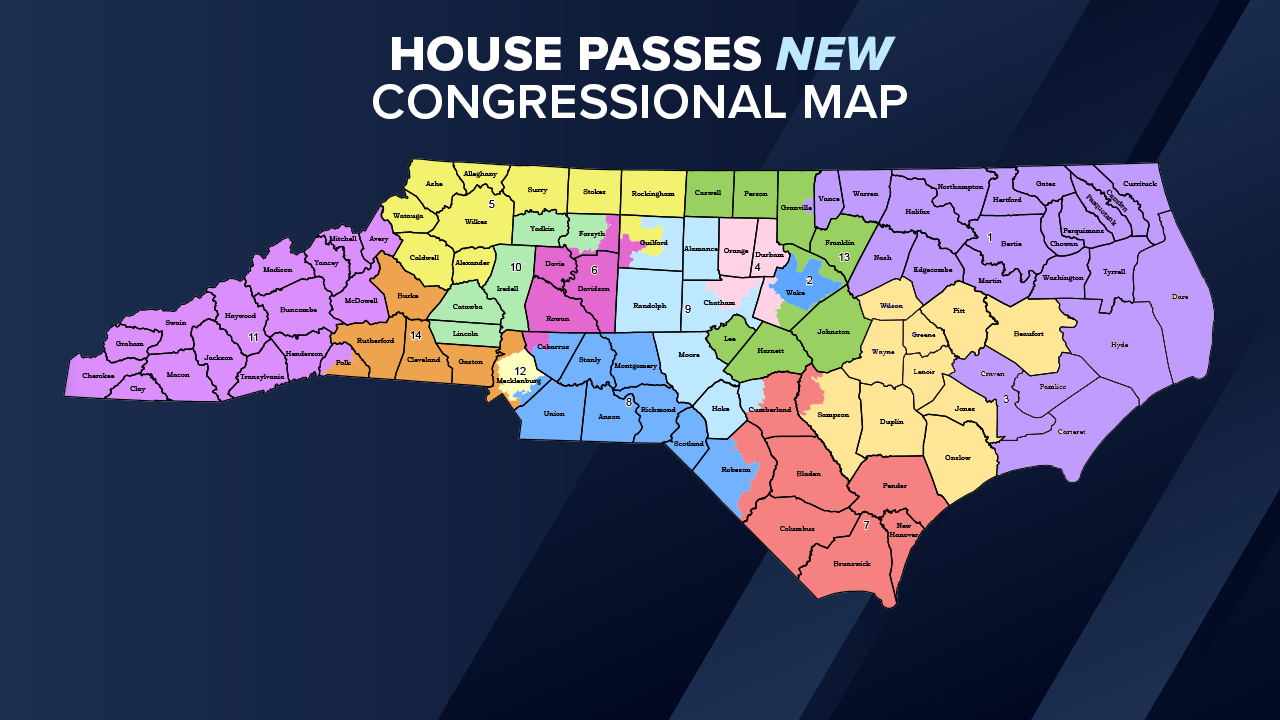RALEIGH, N.C. — The North Carolina House approved a new Congressional voting map Wednesday, which is set to be implemented for the 2026 election.
“The motivation behind this map is straightforward. It moves NC-1 from a district where President Trump won 51% of the vote in 2024 to 55% of the vote, an increase of four points. An end result is a Congressional map that should perform to elect 11 Republicans,” said House Majority Leader Brenden Jones.
This map institutes changes to two districts: District 1 and District 3. District 1, the state’s lone swing seat, is currently represented by Democrat Don Davis, who won his election by less than 2% in 2024. Republican Greg Murphy, who did not face a Democratic challenger in 2024, represents District 3.
It would move Beaufort, Carteret, Craven, Dare, Hyde, and Pamlico counties from District 3 to District 1, while switching Greene, Lenoir, Wayne, and Wilson counties from District 1 to District 3.
“Not only does this new Congressional map better improve Republicans’ strength in eastern North Carolina, the new map adheres to traditional redistricting principles,” said Jones.
Under court-ordered maps in 2022, the state’s Congressional delegation consisted of seven Republicans and seven Democrats. Republicans redrew maps for the 2024 election, leading to the current split of 10 Republicans and 4 Democrats, and are confident this new map will lead to an 11-3 split.
“The map that was adopted today was done within the bounds of the law. And that’s the way that we’ve done redistricting in this state for about 250 years. And so there’s really nothing different about that in this scenario,” said House Speaker Destin Hall.
Republicans publicly introduced the map on Thursday, October 16th. On Monday, October 20th, the Senate voted on the map on second reading, before doing so for a third and final reading on Tuesday. On Wednesday, the House voted on the second and third reading.
“This is highly irregular. We have had a very truncated schedule with less than 24 hours between publication of the map and the beginning of the discussion and the debate in the Senate. The public has had very little time to process and understand what we are doing here today,” said Representative Pricey Harrison, a Democrat who represents Guilford County.
Democrats were further frustrated by the floor debate in the House lasting only an hour.
“This is so important because literally what has been openly said is transparently that we got asked to do this, we’re going to do it,” said House Minority Leader Robert Reives.
Members of the public gathered in the gallery to watch the floor debate on Wednesday. Just moments before a vote was taken, many began to chant and shout, leading them to be escorted from the chamber. A similar scene occurred in a Senate committee hearing on Monday and a House committee meeting on Tuesday.
After the vote, Democratic Rep. Beth Helfrich held hundreds of pages of public comments from people opposing redistricting.
“If you take the time to enter a public comment, you’re asked for your public comment, and it’s not considered by your legislator or by the body in general, I can’t help but think it starts to erode folks trust in the people they elected to serve them and represent their voices here on this floor,” said Helfrich, who represents Mecklenburg County.
Democrats say the maps dilute the voting power of Black voters in the northeastern part of the state.
“Republicans claim that racial data was not used. You didn’t need to use racial data because every single member of this body knows about the Black population in the northeastern part of this state,” said Rep. Gloristine Brown, who represents Pitt County.
Republicans denied coordination with the White House in the creation of the map, which President Donald Trump publicly supported last week.
“Please support this legal proposal to help North Carolina help President Donald Trump make America great again,” shared Rep. Jimmy Dixon, who represents Duplin and Wayne counties.
While Governor Josh Stein has publicly criticized the map, he is unable to issue a veto.
Leadership from both parties, bracing for legal action against the maps.
“I’d be shocked that there’s not legal action. And I really, really hope that the courts understand they are independent, that it does not matter how much they like anybody that’s in office and not in office, that the important thing for the courts to do is to answer your question, how do we make sure that we people have faith in our institution,” said Reives.
“In the last round of redistricting. They were filing lawsuits before the bills were passed. I think the map that you’ve seen passed today will be upheld in any court. We followed the law with it,” said Hall.
Copyright © 2025 WTVD-TV. All Rights Reserved.
Niko Travis is a dedicated health writer with a passion for providing clear, reliable, and research-backed information about medications and mental health. As the author behind TrazodoneSUC, Niko simplifies complex medical topics to help readers understand the benefits, uses, and potential risks of Trazodone. With a commitment to accuracy and well-being, Niko ensures that every article empowers readers to make informed decisions about their health.

